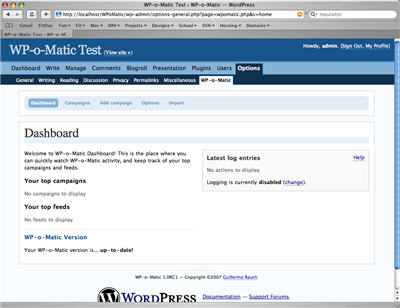WordPress Plugins and Tutorials | Developer Toolbox
It is indisputable that WordPress remains the most popular weblog engine. People prefer it for its simplicity and flexibility. You can find thousands of plugins, themes, tutorials and related articles which are intended to optimize WordPress for your needs. Here is a list of plugins, tools and tutorials that may be helpful in developing web-sites upon WordPress.
WordPress Themes – excellent collection of Free WordPress Themes updated regularly.

WordPress Functional Plugins
AdSense and YPN ads:
AdSense-Deluxe is an easy-to-use plugin for WordPress 1.5+ (including WP 2.0) for quickly inserting Google or Yahoo! ads into your blog posts, and managing when and where those ads are displayed.
Playing Music:
- Audioplayer allows you to insert mp3 audio files into your posts and pages. Audio Player can also play a sequence of audio clips.
- Del.icio.us MP3 Player makes any mp3 links (in post or page or any other location in your blog) playable directly on your webpage. In addition, your visitors will have the opportunity to easily tag and post the mp3 link to del.icio.us. This script is extremely lightweight, as is the flash movie that plays on demand. Must-have for podcasters or anyone who wants to allow blog visitors to play mp3 files on the website itself.
- XSFP Player is a tiny plugin to allow WordPress pages to have background MP3 music embedding this player.
Caching to reduce the server usage:
WP-Cache 2.0 is an extremely efficient WordPress page caching system to make your site much faster and responsive. It works by caching Worpress pages and storing them in a static file for serving future requests directly from the file rather than loading and compiling the whole PHP code and then building the page from the database. WP-Cache allows to serve hundred of times more pages per second, and to reduce the response time from several tenths of seconds to less than a millisecond.
Code cleaner:
HTML Purified is a standards-compliant HTML filter library written in PHP. HTML Purifier will not only remove all malicious code (better known as XSS) with a thoroughly audited, secure yet permissive whitelist, it will also make sure your documents are standards compliant, something only achievable with a comprehensive knowledge of W3C’s specifications.
Comment form:
PXS Mail Form is based on the contact form layout and includes various checks on the entered data and an optional automatic redirect on successful transmission. The plugin will also check that the email address entered is in the correct format.
Data backups:
WordPress Database Backup creates backups of your core WordPress tables as well as other tables of your choice in the same database. For security reasons, WP-DB-Backup requires that you use WordPress version 2.0.3 or newer.
Define and execute your own functions:
Code Markup is a plugin that makes it easy to include program code samples in your posts. You can even include HTML markup in the code sample; Code Markup magically knows which characters should be displayed as code and which should be rendered as HTML.
Enhanced admin interface:
Admin Drop-Down Menu creates a new menu containing all the wanted links (nothing more than a big boring bunch of intricated <ul>’s and <li>’s). No javascript is involved to create the drop down effect, except a tiny bit that gets added when viewed with MSIE.
Feeds to write posts in a smart way:

WP-o-Matic makes autoblogging a snap by automatically creating posts from the RSS/Atom feeds you choose, which are organized into campaigns. WP-o-Matic aims to provide a very wide range of features. Currently, these are: it’s possible to add as many feeds as you want, and add them to as many categories as you want. It’s not obtrusive, so you can also write your own posts to any of those categories. Every form of XML syndication supported. This includes RSS 0.91 and RSS 1.0 formats, the popular RSS 2.0 format, and the emerging Atom. Feed autodiscovery lets you add feeds without even knowing the exact URL.
Google Sitemaps:
Google Sitemaps Generator generates a XML-Sitemap compliant sitemap of your WordPress blog. This format is supported by Ask.com, Google, YAHOO and MSN Search.
Instant comments editor:
WP Ajax Edit Comments allows users and admins alike to edit comments on a post. Users can edit their own comments for a period specified by the admin, and admins can edit all post comments.
Prevent spam:
- Anti-Spam Image Plugin features the following: toggle whether registered users need to enter the word, random font display, auto-generated audio for visually impaired users, no mapping of words from the code — words are used once or removed after 24 hours, reminder of what was entered if you get the word wrong, selective blocking of trackbacks, pingbacks. No cookies and JavaScript required.
- Anti-Spam Image Plugin plugin for WordPress 1.5.2, 2.0.x and 2.1 asks the visitor making the comment to answer a simple math question. This is intended to prove that the visitor is a human being and not a spam robot. This plugin does not require JavaScript or cookies. It uses a special encryption function; the result of the question is being passed via a hidden field. The result is being compared with the value entered by the visitor – after encrypring this value as well.
- Bad Behavior is a set of PHP scripts which prevents spambots from accessing your site by analyzing their actual HTTP requests and comparing them to profiles from known spambots. It goes far beyond User-Agent and Referer, however. Bad Behavior is available for several PHP-based software packages, and also can be integrated in seconds into any PHP script.
- Did You Pass Math? asks the person making the comment to answer a simple math question. This is intended to prove they are a human being and not some kind of robot. e.g. What is the sum of 2 and 9?
- reCAPTCHA is a program that can tell whether its user is a human or a computer. You’ve probably seen them — colorful images with distorted text at the bottom of Web registration forms. CAPTCHAs are used by many websites to prevent abuse from “bots,” or automated programs usually written to generate spam. No computer program can read distorted text as well as humans can, so bots cannot navigate sites protected by CAPTCHAs.

- Simple Trackback Validation for WordPress 2.x performs simple but very effective tests on all incoming trackbacks in order to stop trackback spam. It checks if the IP address of the trackback sender is equal to the IP address of the webserver the trackback URL is referring to. This reveals almost every spam trackback -more than 99% . It also retrieves the web page located at the URL included in the trackback. If the page doesn’t a link to your blog, the trackback is considered to be spam. Since most trackback spammers do not set up custom web pages linking to the blogs they attack, this simple test will quickly reveal illegitimate trackbacks.
Profiles for your users:
- Role Manager allows you to define and manage multiple subscriber profiles – called Roles and their Capabilities. Also you can create new Roles and Capabilities. If you use this Plugin to manage your WordPress, Users can belong to only one role and can have individual capabilities assigned to them outside of the context of a role.
- Red Alt’s role manager provides this level of functionality in WordPress. Drop in this plugin and you’ll be creating custom roles in seconds. It comes with a very slick AJAX interface, and let’s you see all permission capabilities at a glance. This plugin takes account management to a new level.
Execute Php-commands:
Exec-PHP executes code inside of <?php ?> tags by just wrapping your whole text into ?> <?php tags and hand it over to the PHP eval() function. By that no parsing of your code needs to be done by the plugin itself.
RSS subscription:
Feedburner Plugin detects all ways to access your feed (e.g. http://www.yoursite.com/feed/ or http://www.yoursite.com/wp-rss2.php, etc.), and redirect them to your FeedBurner feed so you can track every possible subscriber. It will forward for your main posts feed, and optionally your main comments feed as well.
Add to Any Subscribe Button allows your readers to subscribe via most popular RSS readers.
RSS Feed Tools:
- ©Feed adds content to a feed. It is possible to configure the copyright message. You can use HTML. You can add the IP of a feed reader and digital fingerprint for an explicit key. It is also possible to add comments and related posts to the feed. For the related post feature it uses a database-search for the content. You can use the plugin “Simple Tagging” for related posts in a feed. The copyright notice can be added even when using entry excerpts.
- Better Feed – Adds a “read more” button, a copyright notice, and a “Add to del.icio.us” link.
- DeCat allows you to hide a specific category from the rss/atom feeds (e.g. a glossary-category). Install it as usual, configuration via Plugins->DeCAT, no warranty for anything, licensed under the WTFPL.
- Feed Control allows you to change how WordPress generates the main feeds that the update services use. From here you can add Pages to your feeds or remove posts from them. You also have the option to exclude specific posts or pages based on their ID and can also set the sort options to use modified date instead of post date.
- Feed Footer is a plugin that allows you to add footers under all your blog posts in your RSS feed. With this plugin, you can: add copyright notices under all your Blog Posts in the RSS feed, show and rotate ads under your blog posts in the RSS feed (maximum of 10 ads can be rotated). Any HTML code can be shown in your footers! You can snazzy up your footers with banners and images. You can make your text bold or italics or underlined. Your footer ads and notices could be up to 200 lines long.
- Feed Master assigns a (pseudo-random) ID to every person that read your feed. It’s a technique that many people on the web have thought, although its use isn’t much widespread.
- Feed Styler is for those that use WordPress, are comfortable with CSS, and would like to be able to use their existing markup to style their feeds. Feed Styler is very effective at styling images, blockquotes, and much more. If you are a hand coder and familiar with CSS, Feed Styler will be very intuitive.
- FeedStats provides you with statistical data on your feeds. It allows customize in options: amount of days that is supposed to be saved in the statistics; minimum level of WordPress-user, who is allowed to see the statistics; time of a stay/visit; visitors online time; IP, that is supposed not to be saved, ex.: your own IP. Statistics can be shown on the dashboard.
- Slash Comments plugin adds the
slash:commentstag to RSS feeds, which tells feed readers such as Google Reader or Bloglines how many comments there currently are on that post. - Subscribe-Remind automatically places some text at the end of each of your posts inviting your readers to subscribe to your RSS feed. It’s an unobtrusive and effective way to turn visitors into subscribers.
Search Tools:
- Search Regex adds a powerful set of search and replace functions to WordPress. These go beyond the standard searching capabilities, and allow you to search and replace almost any data stored on your site. In addition to simple searches you have the full power of PHP’s regular expressions at your disposal.
- Head-Meta Description provides an automatic meta description tag for your blog, inserting a dynamic description depending on the query-type (i.e. page you’re on). Some particular search engines are supposed to love this tag.
Stylesheet switcher:
CSS Ajax Switcher allows you to add CSS switching to your theme without any reload. It also stores the users selection for future visits. This plugin uses UDASS The Unobtrusive Degradable Ajax Style Sheet Switcher.
Tagging system:

Simple Tagging provides you with everything you need for tagging. It allows to import your tags from UTW or Jerome’s Keywords. Display Tags of the current posts. It allows to create a tag cloud with various options, display a list of related posts, add tags as meta keywords in the header, adding tags as categories in the feed (this will index your tags with Technorati). It simplifies tag management – you can rename, delete, replace tags, convert categories to tags, etc.
Displaying Data with WordPress
Create archives in a smart way:
Smart Archives for WordPress is a rather simple WordPress plugin that will allow you to display your archives in a much “cleaner” format. You can see it in action on my archives page. You’ll notice that everything on the page is hyperlinked (years, months, posts) and that all of the respective links are future-proofed.
Display popular posts:
Popularity Contest keeps a count of your post, category and archive views, comments, trackbacks, etc. and uses them to determine which of your posts are most popular. There are numerical values assigned to each type of view and feedback; these are used to create a ‘popularity score’ for each post. The values assigned to each view and feedback type are editable and can be changed at any time. When you change any of these values, the ‘popularity score’ for all posts are updated immediately to reflect the new values. Since Popularity Contest hooks into the WordPress code that actually displays post content, any caching plugin (like WP-Cache) will affect the ability of Popularity Contest to accurately record views.
Enable Avatars:
- Gravatars adds an author’s icon functionality in comments.
- Favatars is a plugin that enables each comment/pingback/trackback to be accompanied by the website favicon (if available). A little less cryptically, this means that when a user on your blog leaves a comment/ pingback/ trackback, if they supply a URL, the plugin will see if their website has a favicon – if they do have a favicon, then you will have the option of making it show up on your blog right next to their name.
- MBLA can add avatars from i.e. MyBlogLog and Gravatar to blog posts and comments. You can easly switch between MyBlogLog and/or Gravatar avatars. The output is fully CSS and HTML customizable and the plugin comes with a built in cache control – everything is handled through MBLA’s own option page.
Enhance WordPress as a CMS:
CMS Enabling Plugins: WordPress contains almost all the features you need to get it going as a CMS out of the box. However, you’ll find that there are a few things missing that make up the final pieces of the puzzle. Here’s an overview of the five most useful plugins I’ve found, and the part they play in making WordPress a butt-kicking CMS.
Footnotes:
WP Footnotes allows to create footnotes in your blog “on the fly”. Also paginated posts are supported. Sometimes it’s useful to be able to refer to a previous footnote a second (or third, or fourth…) time. To do this, you can either simply insert the exact same text and identifier should simply reference the previous note.
Help landing users find what they need:
Landing sites 1.3 When visitors is referred to your site from a search engine, they are definitely looking for something specific – often they just roughly check the page they land on and then closes the window if what they are looking for isn’t there. Why not help them by showing them related posts to their search on your blog?
Pagination:
WP-PageNavi adds a more advanced paging navigation your WordPress blog. Example: Pages (17): [1] 2 3 4 » … Last».
Podcasting Tools:
Podpress: :all-singing, all-dancing podcasting tool for WordPress. Supports unlimited number of media files. Preview image for videos. Support for separate Category podcasts. Audio Comments, and more.
Sidenotes:
fQuick is a plugin for WordPress which enables the user to add small custom quicklinks to the sidebar. With RSS feed for easy syndication.
sIFR for your headlines:
CG-FlashyTitles a drop-in Plugin for sIFR 2.0 Flash-based title replacements.
Show similar and related posts:
Similar Posts is a plugin that displays a list of posts which are related or similar to the current post. It compares posts by comparing their words. MySQL has a sophisticated full-text searching facility with a carefully tuned algorithm for judging the similarity between texts. Similar Posts extracts the most frequent words from a post’s content and title (ignoring a set of common ‘noise’ words) and uses the full-text index to find the best matches between posts. This simple approach gives surprisingly good results.
Show your current events:

Event Calendar lets you manage future events as an online calendar. Display upcoming events in a dynamic calendar, on a listings page, or as a list in the sidebar.
Show your favourite books:
Now Reading is an expansive WordPress plugin which allows you to maintain a virtual library of books. Display which you’ve read, which you’re currently reading, and which you plan to read; add metadata to describe them; write reviews detailing what you thought of them. Now Reading fetches its data from any Amazon domain, so all you need is an ISBN or book title and you’re good to go.
Stick a post:
Adhesive allows you to easily mark certain posts as “Sticky”. Sticky posts appear at the top of the page when WordPress displays several posts.
Title presentation:
Optimal Title is a plugin that mirrors the function of wp_title() exactly, but moves the position of the ‘separator’ to after the title rather than before. This allows you to have your blog name tacked on to the end of the page title instead of having it appear first.
WordPress Tutorials
Comment Styling in WordPress and How-to style WordPress author comments without the need for extraneous plugins. Using the flexibility of Cascading Style Sheets (CSS), it is possible to differentiate between specific user comments using different background colors, background-images, or fonts.
Styling Page-Links.Did you know you could split a single post up into different web pages? Using the Next-Page Quicktag from the Write Post Panel, you can break a single post up into different web pages. Called the Page-link tag, place your cursor in the spot where you want a page break to appear in your post and click the Next-Page Quicktag. You can use it throughout a long post to make two, three, four, or more pages out of the single post.
How to Take Full Advantage of Your Post Timestamp. WordPress enables you to set the date for something into the future—think of it as a dorky sort of time travel—so that you can write (if you wanted to) weeks worth of posts in an afternoon. WordPress will “update” your blog by posting your content at the time you specify each day.
Author Comment Highlighting and Author Highlighting Through Theme Options gives detailed information on styling author’s comments.
Resources & Articles
How to create WordPress theme from scratch – 16 articles, which represent a step-by-step instruction on how to create WordPress themes from the very beginning to the end.
Things you should know when displaying pages in WordPress is a quick guide on things WordPress users should know with listing Pages.
Things you should know when using post excerpt is a detailed tutorial on how-to use excerpt and where to use them. While many use it to make things more aesthetic, displaying excerpt has got many advantages both in the SEO, magnetization and traffic area. There are also further things you should be knowing and setting up when using post excerpt which I shall be describing in this post.
How-to turn visitors into returning visitors – requisite WordPress plugins to make visitors feel at ease. Helping people especially first time visitors feel at ease is an important aspect both to contain traffic thus turning visitors into subscribers for establishing a readership. Your blog’s design and navigational structure count but here you can find some additional goodies you could add to make visitors stick to your blog after a first time visit or revisit.
The proper way to write code in your blog posts – is a tutorial which shows how to write any code for any language the proper way, that is one in which it won’t be executed but nonetheless your visitors will be able to copy and use the code without any manoeuvre.
Quick shooting stats of your WordPress blog – show the number of posts,comments and categories you have to allow your visitors and yourself a broad view of your blog’s current state updated as these criteria change.


October 25 at 10:07 am
Hi,
it’s a nice list, thank you.
I have only one note: Red Alt’s Role Manager only works with WordPress-versions up to 2.0. It’s don’t working with 2.1 and later.
October 25 at 6:19 pm
Very useful, thanks.
October 28 at 5:41 pm
Does anyone know how to make the MATH question code to work if you have custom design on the regiatration page instead if just plain pages??
Also, are the trackbacks better – equal – or worse than the math question??